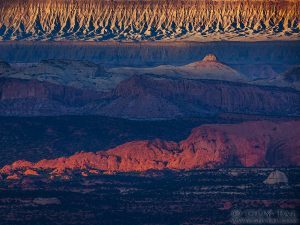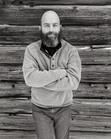The Implicit Contract
A work of art is the unique result of a unique temperament. Its beauty comes from the fact that the author is what he is. It has nothing to do with the fact that other people want what they want. Indeed, the moment that an artist takes notice of what other people want, and tries to supply the demand, he ceases to be an artist. ~Oscar Wilde
There are two magazines that I contribute to regularly—LensWork, and On Landscape. They are different publications in many ways (one is a printed magazine, the other electronic; one focuses on landscape photography, the other inclusive of all genres; etc.). Both publications are created and curated with care and passion by their publishers, and both are subscription-based, rather than being funded by advertising, making them a pleasure to read without distraction. More to the point of this post, these publications have another thing in common, which is this: both foster serious and intelligent discussion and commentary about photography beyond just technical topics.
I was pleased that my recent article in On Landscape, titled, “Morality and Realism in Photography,” elicited some excellent and well-thought-out responses and led to an offline discussion with the publisher, Tim Parkin, that resulted in a follow-up article written by Tim, titled, “Realism and Honesty in Photography.” In his article, Tim proposes that there is an implicit contract between photographers and viewers, which he describes as “the ‘fair’ expectation that what you are being presented with meets certain criteria even though there is no explicit contract.”
I believe that such an implicit contract in photography exists (or should exist) only in some contexts, and that there is no such contract that applies unequivocally to all photographs. To the point of this article: I believe that there is no such implicit contract when it comes to photographs intended as art (indeed, to anything intended as art).
To suggest that artists, in any medium, should tailor their work to viewer expectation is to suggest that art should become stagnant. This is because all advances in art and artistic expression originated with artists who defied conventions, broke with traditions, and did things in new ways. In that sense, novel exceptions are to the evolution of art what mutations are to the evolution of life—not always successful, but wen they are, leading to new forms.
It can be said that we have an implicit contract with news media to be truthful in their reporting, although we know that some of them, by design, offer biased and sometimes even false views. We may believe that we have an implicit contract with physicians to treat everyone equally, but such a view does not reconcile with some surveys, such as one that found physicians less likely to prescribe certain drugs to family members than to random patients for the same condition. We want to believe that we have an implicit contract with law enforcement officers and with the judicial system to treat the everyone fairly and equally, but studies show significant biases (racial, demographic, etc.) in the likelihood of being arrested for certain crimes, and in the severity of court-imposed penalties. To wit, trusting an implicit contract without further critical assessment may lead to error and disappointment.
When it comes to photography, I agree completely that viewers have a legitimate expectation—an implicit contract with the photographer—that what they are shown is a truthful representation (to the extent that this is possible). And certainly, when such an expectation is not met, viewers have every right to be upset and to feel like they have been deceived.
However, when it comes to art, there is no such contract—no legitimate expectation of truthful representation. Indeed, if all one could do with photography is to represent appearances as anyone else would see them, photography would be a decidedly-unsuitable medium for art. Art, deriving from the same origin as “artificial,” by any formal definition, is a product of human skill and imagination, and is not strictly defined by any other criteria. Skill and imagination are what philosophers call “necessary and sufficient conditions” for something to be considered art. More explicitly, truthfulness, however you choose to define it, is not one of these conditions.
Where there is an implicit contract that is not honored, the injured party has a legitimate reason to feel deceived. But to suppose there is an implicit contract where there is no plausible reason to assume so, is to be gullible or at least uninformed. For a variety of reasons, such misinformation is more pervasive in photography (when used to make artistic creations) than in other media. As such, I consider it my duty as a photographer who considers himself an artist, to inform that such a contract should not be assumed for any photograph presented as art. And I urge my fellow photographic artists to similarly step up. Misinformation among potential audience for photographic art is not in our favor and may lead to preventable disappointment.
As I wrote in my On Landscape article, “Readers know to apply different modes of appreciation to works of journalism and to works of fiction. Moviegoers can easily tell the difference between a documentary film and a fictional one. There is no reason why these same people can’t be encouraged to make the same distinctions when studying photographs.” Not only will such educated viewers be less prone to disappointment, but they also will expand the range of rewards they will get from photography. The fact that a fictional novel is not as truthful as an academic textbook does not make one unequivocally “better” than the other, but it does mean that the two should be read with different expectations and reward readers in different ways. Photography has a broad range of expression—both factual and expressive. To allow people to persist in their belief that photographers are only “allowed” to use a small part of that range is not only detrimental to artistic expression, but it also is untenable: photographs that do not represent “real” appearances not only exist but are common, and there is nothing and no one who can change that. We should stop pretending that this is not the case, or that this is a bad thing.
With that said, I would like to explain the extent of what Ansel Adams called “departure from reality” in my own work, and without judgment of other people’s work who may choose differently. I consider my photographs as visual journal entries. Personal journals describe real events, but they do so in a subjective way: they not only express what happened, but how it affected the writer. In a personal journal, the event and the feelings it inspired in the writer are both true, even if another person may have had a different impression of the same event.
I don’t photograph to make photographs, nor to commemorate events just because their appearance is attractive. I photograph to express moods inspired by encounters with things and places that are personally meaningful to me. As such, I have no reason to depart too far from the sources of my inspiration, however what I choose to show you and how I choose to portray it are entirely subjective and not likely to match what you would have seen or felt in the same circumstances.
Allow me to also address the ignorant stigma of “manipulation.” All art, being by definition a product of human skill, is manipulation. A view occurring naturally or randomly, presented without application of human creativity, by definition is not art. What may not be obvious from this definition is that a photographer’s primary tool for manipulation is visual composition: the deliberate arrangement of visual elements within the frame by such choices as perspective, what lens to use, what lighting or weather conditions to match with a given subject or scene, and others. All such decisions and techniques are innate to the photographic process and require no means other than a camera and lens; and all can be used to express things that are truthful and things that are not.
Processing the captured photograph is a secondary means for manipulating photographs. In my work, my purpose in applying processing tools is not solely aesthetic appeal. Rather, my purpose is to arrive at the (truthful) emotional effect I experienced and wish for my images to impart, using the (real) properties—colors, textures, lines, etc.—of the things in my photographs. Note that this does not mean that I portray these things as-is. I will emphasize and enhance those aspects of the captured photograph, so they best fit my expressive goal, but I—by choice—will not to create images from arrangements that are not possible in a single photograph. This is because what I wish to express ensues directly from real things.
These are choices I make to match my reasons and purpose in practicing photography, and not because I feel bound by any implicit contract. Others may, and do, make different choices or have different purposes in photography. So long as such photographs are presented as art, no implicit contract can be assumed, because to do so is gullible and will almost always lead a viewer to incorrect assumptions.




